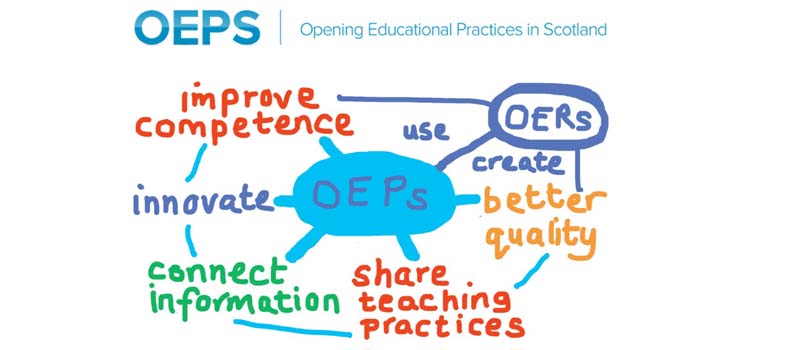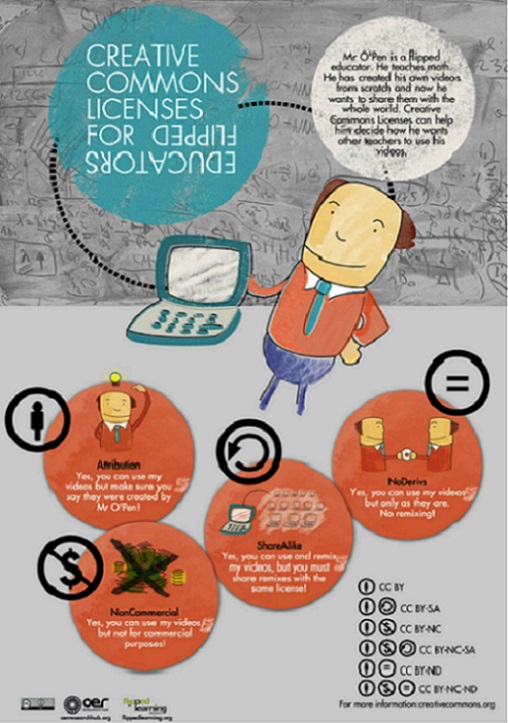This picture shows a cartoon drawing of a man holding a laptop. The man is on the right-hand side of the picture, the computer is to his left. The man is wearing a red shirt with a white collar, a blue tie and blue trousers. Above the man is a thought bubble which states: ‘Mr O’Pen is a flipped educator. He teaches math. He has created his own videos from scratch and now he wants to share them with the whole world. Creative Commons licenses can help them decide how he wants other teachers to use his videos.’ To the left of the thought bubble and above the laptop is a circle with the statement ‘Creative Commons licenses for flipped educators’, the words ‘flipped educators’ are printed upside down. Below the man are 4 circles.
The first circle on the left-hand side of the picture has a picture of the man with a lightbulb above his head, underneath this picture is the title ‘Attribution’, below this is the statement ‘Yes, you can use my videos but make sure you see they were created by Mr O’Pen!’. Attached to the top-left of the first circle is a symbol comprising a circle with a stick figure of a person in the middle.
The second circle is also on the left-hand side of the picture, but is below the first circle. The second circle has a picture of piles of money with a cross through them; underneath this picture is the title ‘NonCommercial’; below this is the statement ‘Yes, you can use my videos but not for commercial purposes!’. Attached to the top-left of the second circle is a symbol comprising a circle with a dollar sign in the middle and a strikethrough from top-left to bottom-right.
The third circle is in the middle of the picture, slightly below the first circle and slightly above the second circle. The third circle has a picture of one laptop on the left-hand side and 13 laptops in 3 rows on the right-hand side; there is a line connecting the one laptop to the group of laptops. Underneath the picture is the title ‘ShareAlike’, and below this is the statement ‘Yes, you can use and remix my videos, but you must share remixes with the same license!’. Attached to the top-left of the third circle is a symbol comprising a circle with a circular arrow in the middle pointing anticlockwise.
The fourth circle is on the right-hand side of the picture, slightly above the third circle and in line with the first circle. The fourth circle has a picture of the man handing a CD to another man, with both men facing each other and smiling. Underneath the picture is the title ‘NoDerivs’, and below this is the statement ‘Yes, you can use my videos but only as they are. No remixing!’. Attached to the top-right of the fourth circle is a symbol comprising a circle with the equals (=) symbol in the middle.
In the bottom-right of the picture below the circles is a list of the symbols. From top to bottom, the list reads:
- Symbol comprising a circle with a stick figure of a person in the middle of the circle, beside this is the phrase ‘CC BY’.
- Symbol comprising a circle with a stick figure of a person in the middle of the circle and the symbol comprising a circle with a circular arrow in the middle pointing anticlockwise, beside this is the phrase ‘CC BY-SA’.
- Symbol comprising a circle with a stick figure of a person in the middle of the circle and the symbol comprising a circle with a dollar sign in the middle and a strikethrough from top-left to bottom-right of the circle, beside this is the phrase ‘CC BY-NC’.
- Symbol comprising a circle with a stick figure of a person in the middle of the circle; the symbol comprising a circle with a dollar sign in the middle and a strikethrough from top-left to bottom-right of the circle and the symbol comprising a circle with a circular arrow in the middle pointing anticlockwise; beside this is the phrase ‘CC BY-NC-SA’.
- Symbol comprising a circle with a stick figure of a person in the middle of the circle and the symbol comprising a circle with the equals symbol in the middle; beside this is the phrase ‘CC BY-ND’.
- Symbol comprising a circle with a stick figure of a person in the middle of the circle; the symbol comprising a circle with a dollar sign in the middle and a strikethrough from top-left to bottom-right of the circle and the symbol comprising a circle with the equals symbol in the middle; beside this is the phrase ‘CC BY-NC-ND’.
Underneath this list is the phrase ‘for more information: creativecommons.org’.
In the bottom-left of the picture below the circles are 3 logos.
The first logo is the symbol for CC BY; this is a rectangle with the top half in grey and the bottom half in black; on the left-hand side is a white circle with a black border with the letters ‘CC’ in the centre, and on the right-hand side the symbol comprising a circle with a stick figure of a person in the middle of the circle, with ‘BY’ underneath it.
The second logo is for the OER research hub. This has an image of a radial on the left-hand side, with the word ‘OER’ on the right-hand side and the phrase ‘research hub’ underneath ‘OER’; underneath this is the phrase ‘oerresearchhub.org’.
The third logo comprises the word ‘flipped’ starting on the left-hand side, then the word ‘learning’ underneath this, where the second ‘P’ of ‘flipped’ stretches down to create the ‘L’ of ‘learning’. Underneath this is the phrase ‘flippedlearning.org’.

